The AMD Threadripper 2990WX 32-Core and 2950X 16-Core Review
by Dr. Ian Cutress on August 13, 2018 9:00 AM ESTHEDT Benchmarks: Office Tests
The Office test suite is designed to focus around more industry standard tests that focus on office workflows, system meetings, some synthetics, but we also bundle compiler performance in with this section. For users that have to evaluate hardware in general, these are usually the benchmarks that most consider.
PCMark 10: Industry Standard System Profiler
Futuremark, now known as UL, has developed benchmarks that have become industry standards for around two decades. The latest complete system test suite is PCMark 10, upgrading over PCMark 8 with updated tests and more OpenCL invested into use cases such as video streaming.
PCMark splits its scores into about 14 different areas, including application startup, web, spreadsheets, photo editing, rendering, video conferencing, and physics. We post all of these numbers in our benchmark database, Bench, however the key metric for the review is the overall score.
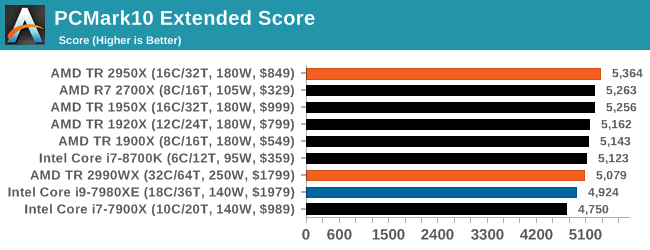
One of the downsides of PCMark is that it seems to bunch up all the results, showing them relatively close together, but interestingly here that the Intel processors sit near the bottom, with the 2950X and 2700X on the podium.
Chromium Compile: Windows VC++ Compile of Chrome 56
A large number of AnandTech readers are software engineers, looking at how the hardware they use performs. While compiling a Linux kernel is ‘standard’ for the reviewers who often compile, our test is a little more varied – we are using the windows instructions to compile Chrome, specifically a Chrome 56 build from March 2017, as that was when we built the test. Google quite handily gives instructions on how to compile with Windows, along with a 400k file download for the repo.
In our test, using Google’s instructions, we use the MSVC compiler and ninja developer tools to manage the compile. As you may expect, the benchmark is variably threaded, with a mix of DRAM requirements that benefit from faster caches. Data procured in our test is the time taken for the compile, which we convert into compiles per day.
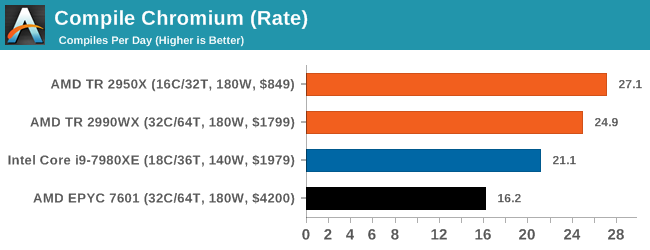
This test is such a nice mix of ST, MT, and memory limited flow that it is really interesting to see where the results end up. Unfortunately for our new suite the output files were not set up correctly, so despite running the test we only ever got a handful of results. But it shows an interesting metric: the 2950X sits ahead of the 2990WX, with both ahead of the Core i9, and the EPYC system being beaten handily due to its lower frequencies.
3DMark Physics: In-Game Physics Compute
Alongside PCMark is 3DMark, Futuremark’s (UL’s) gaming test suite. Each gaming tests consists of one or two GPU heavy scenes, along with a physics test that is indicative of when the test was written and the platform it is aimed at. The main overriding tests, in order of complexity, are Ice Storm, Cloud Gate, Sky Diver, Fire Strike, and Time Spy.
Some of the subtests offer variants, such as Ice Storm Unlimited, which is aimed at mobile platforms with an off-screen rendering, or Fire Strike Ultra which is aimed at high-end 4K systems with lots of the added features turned on. Time Spy also currently has an AVX-512 mode (which we may be using in the future).
For our tests, we report in Bench the results from every physics test, but for the sake of the review we keep it to the most demanding of each scene: Ice Storm Unlimited, Cloud Gate, Sky Diver, Fire Strike Ultra, and Time Spy.

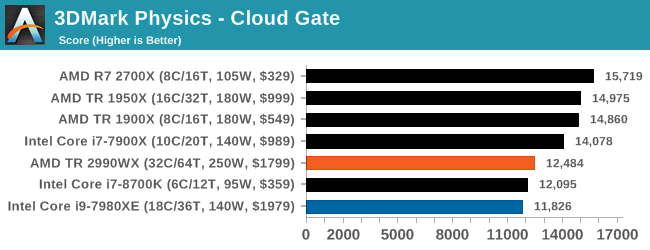

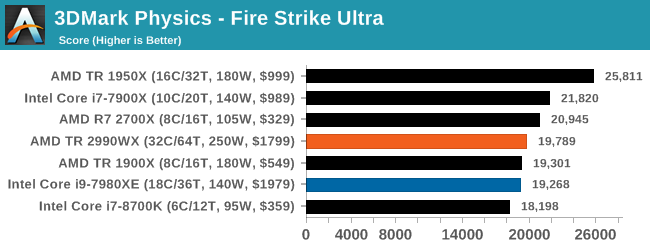
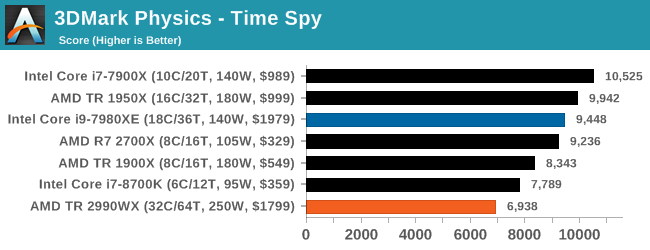
In the low end tests, it is clear that having these big processors doesn’t do much for performance, but even as we go up through Fire Strike and Time Spy, there seems to be a natural limit to the usefulness of these parts. Physics clearly loves having some extra memory bandwidth, and we know Time Spy isn’t meant to scale beyond about 10 cores, but we do see the 10 core processor sitting out front. Some of our testing sweeps had this benchmark configured incorrectly so it will be interesting to see how it fills out with some other mid and high core count processors.
GeekBench4: Synthetics
A common tool for cross-platform testing between mobile, PC, and Mac, GeekBench 4 is an ultimate exercise in synthetic testing across a range of algorithms looking for peak throughput. Tests include encryption, compression, fast fourier transform, memory operations, n-body physics, matrix operations, histogram manipulation, and HTML parsing.
I’m including this test due to popular demand, although the results do come across as overly synthetic, and a lot of users often put a lot of weight behind the test due to the fact that it is compiled across different platforms (although with different compilers).
We record the main subtest scores (Crypto, Integer, Floating Point, Memory) in our benchmark database, but for the review we post the overall single and multi-threaded results.












171 Comments
View All Comments
Ian Cutress - Monday, August 13, 2018 - link
It looks like the 2950X are reversed (C++ should be OpenCL), but I checked the raw data and that's what came out of the benchmark. I need to put the 2950X back on to test, I'll do it in a bitStuka87 - Monday, August 13, 2018 - link
Thanks for getting this up Ian! An awesome read per usual :)deathBOB - Monday, August 13, 2018 - link
The interconnect analysis was very interesting, glad you spent time on that.mapesdhs - Monday, August 13, 2018 - link
Yes, that was good. I had flashbacks to reading SGI Origin technical reports 20 years ago. :Dhttp://www.sgidepot.co.uk/origin/isca.pdf
http://www.sgidepot.co.uk/origin/hypercube.pdf
Index: http://www.sgidepot.co.uk/origin/
I see a great many similarities, though the emphasis is different (SGI was all about bandwidth rather than latency, for extreme I/O and huge datasets in shared memory, though they greatly improved the latency behaviour with the 2nd-gen design). Fascinating to see many of the same issues play out in the consumer space, but for rather different tasks, though I bet a lot of researchers in industry and academia will be taking keen interest in what AMD has released.
close - Monday, August 13, 2018 - link
"They will enable four cores per complex (8+8+8+8) and three cores per complex (6+6+6+6)"3/4 cores per complex or 6/8 cores?
MrSpadge - Monday, August 13, 2018 - link
The 8 cores per die are distributed over 2 CCX core complexes with 4 cores each, as in Ryzen 1.FreckledTrout - Monday, August 13, 2018 - link
LOL You actually ran tests with the plastic on? That is just funny. Did the plastic melt?Ian Cutress - Monday, August 13, 2018 - link
It ran fine, though the numbers suggest the thermals reduced PB2/XFR2 turbo by a fair bit. Some tests look a bit down. Still writing it up :)FreckledTrout - Tuesday, August 14, 2018 - link
Hilarious. That does sound like something I would do in a hurry. I see you have a whole section awaiting for plastic vs no plastic thermals. I bet that will be an Anandtech only talking point. :)msroadkill612 - Thursday, August 16, 2018 - link
A coredom?